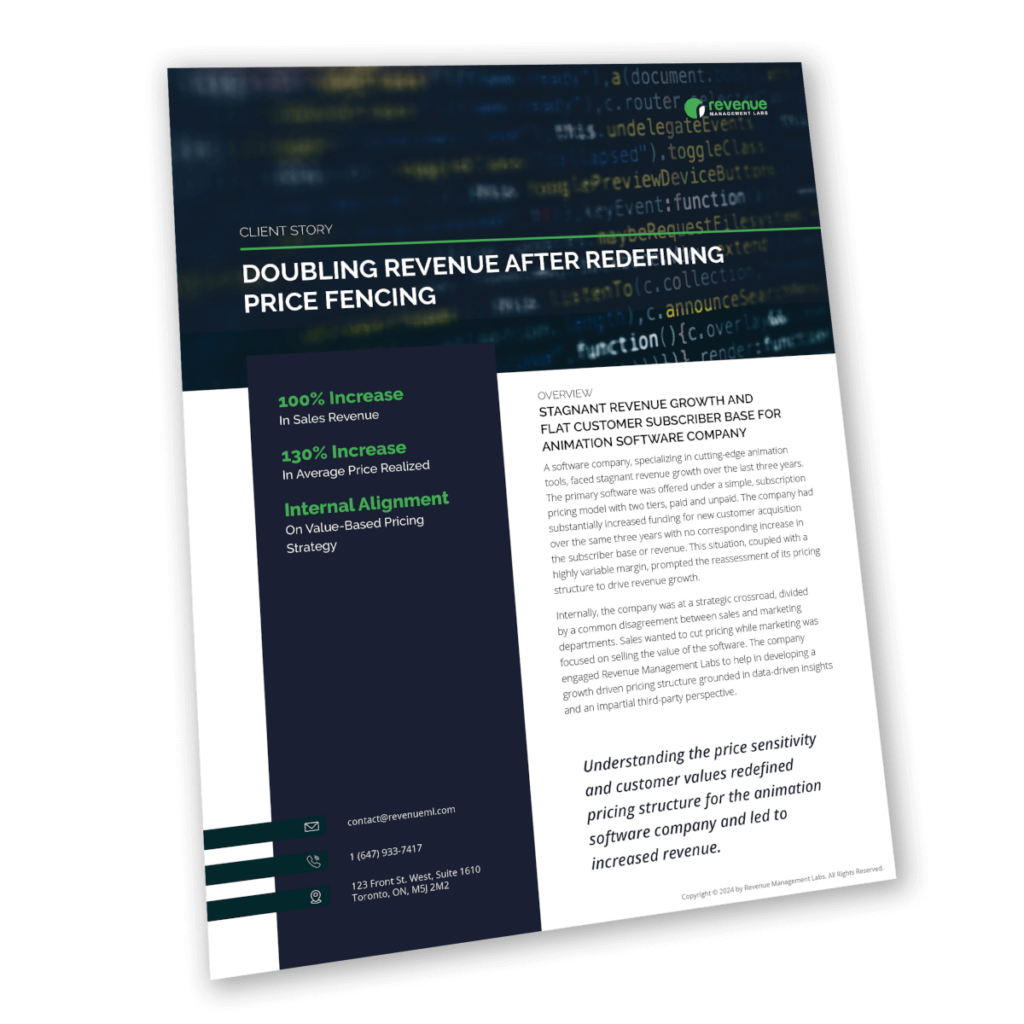Understanding the price sensitivity and customer values redefined pricing structure for animation software company and led to increased revenue.
A software company, specializing in cutting-edge animation tools, faced stagnant revenue growth over the last three years. The primary software was offered under a simple, subscription pricing model with two tiers, paid and unpaid. The company had substantially increased funding for new customer acquisition over the same three years with no corresponding increase in the subscriber base or revenue. This situation, coupled with a highly variable margin, prompted the reassessment of its pricing structure to drive revenue growth.
Internally, the company was at a strategic crossroad, divided by a common disagreement between sales and marketing departments. Sales wanted to cut pricing while marketing was focused on selling the value of the software. The company engaged Revenue Management Labs to help in developing a growth driven pricing structure grounded in data-driven insights and an impartial third-party perspective.
Several factors could be contributing to the flat revenue over the past three years at the animation software company. The stagnant customer subscriber base was the obvious first area to explore when investigating pricing. The company used a simple two-tiered pricing with a paid, regular license priced at $499 and an unpaid student license. The simple two-tiered pricing model was clearly not resonating effectively with potential customers given the ineffective customer acquisition investment but there could be other factors, such as how the value proposition is being communicated, competitive landscape, and market perception, that could contribute to the stagnation.
In Sales Revenue
In Average Price Realized
On Value-Based Pricing Strategy

Review the advanced analytics behind our pricing strategy and the increase in revenue.
Revenue Management Labs recommended shifting from the simple two-tiered pricing system to a four-tier pricing system, a more nuanced approach to pricing and considered factors such as customer segment, tenure (how long the customer has been with the company), required licenses, and price sensitivity. Our experts applied advanced analytics to redefining the price fencing strategy for the software company based on value identification and a combination of customer surveys and data analysis. This approach is not only applicable to software pricing but also holds significant potential for implementation across various industries.
The first step to identifying pricing opportunities was to analyze the current customer base. The pricing experts at Revenue Management Labs used a mixed-method approach, consisting of both customer interviews and transactional cluster analysis. From that analysis, we uncovered four key customer segments: Movie Studios, Video Game Manufacturers, Corporate TV and Online Commercials, and Students.
The second part of our analysis focused on analyzing the main factors behind each groups’ purchasing decision. We used a MaxDiff analysis to uncover the most important purchase attributes. Then we combined the insights from the cluster and MaxDiff analysis to create a unique profile for each customer segment and the pricing structure.
For a detailed review of the pricing methodology and data analysis,
download the full case study on price strategy for software and technology companies.
The shift from a single price point to a multi-tiered package structure yielded remarkable outcomes, including a staggering 130% increase in sales. This transition translated into a substantial rise in both the average realized price and the overall revenue. Crucially, the project shed light on the detrimental effects of price reduction strategies aimed at boosting short-term volume, uncovering their destructive impact on value and profitability.
This realization spurred the company to adopt a fresh perspective on fostering growth by prioritizing price optimization over volume-centric approaches.
We are here to help you achieve profitable revenue growth
Phone: +1 (647) 933-7417
Inquiries: contact@revenueml.com

We will cover the full results from our 2024 Executive Pricing Survey. See how you compare to your competitors both in past performance and for 2024 pricing strategy.